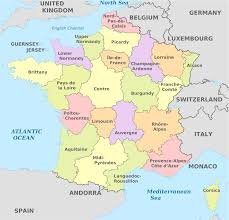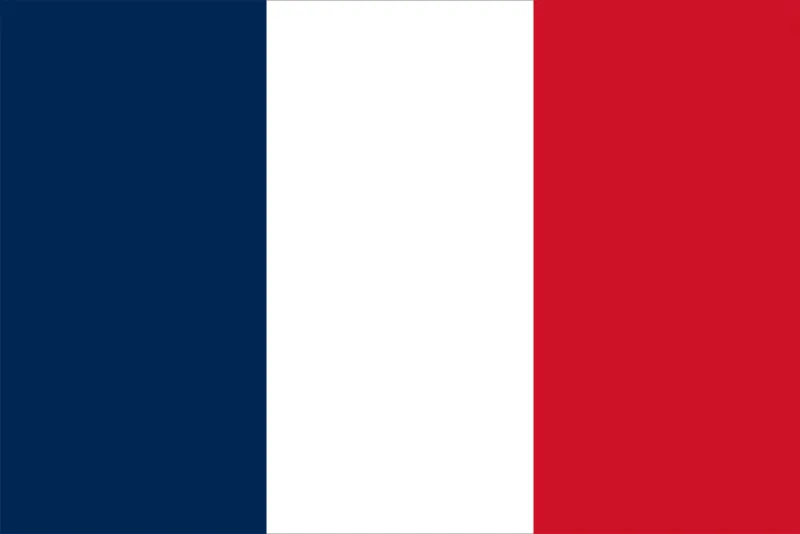Geography of France • Maps • Interesting Facts • Flag
France FactSheet:
- Area: 643,801 km ²
- Population: Over 68.3 Million(2024)
- Population Density: ~122 people/ km ²
- Climate Type: MostlyTemperate
- Dominant Language: French
- Dominant Religion: Roman Catholicism(Christianity)
- Currency: Euro
- Government: Semi-presidential republic
- GDP: 3.76 Trillion USD in 2024
- Major Export: Aircraft, Packaged medicine, Cars, natural gas
- Capital: Paris
France Flag:

The Flag of France has got three equal vertical bands of blue (hoist side), white, and red; known as the “Le drapeau tricolore” (French Tricolor), the origin of the flag dates to 1790 and the French Revolution when the “ancient French color” of white was combined with the blue and red colors of the Parisian militia; the official flag for all French dependent areas
History of France:
More than 100,000 years ago, people lived in what is now France. Around 1200 bc, a Celtic group known as the Gauls moved to the region. The area was taken over by the ancient Romans, who named it Gaul, by around 50 bc.
German tribes invaded Gaul when the Roman Empire waned. France got its name from the Franks, who were the most powerful of the tribes. Charlemagne, who ascended to power in 768 CE, was the greatest of the Franks. The majority of western Europe was under Charlemagne’s empire by the early 800s. However, the empire was split into three sections after Charlemagne’s death. The western region was dubbed the Kingdom of France after 843.
France rose to prominence as Europe’s most powerful nation in the 1600s. During his 1643–1715 reign, Louis XIV expanded the king’s authority to unprecedented levels. However, France lost a string of expensive wars abroad in the 1700s. Domestically, political unrest and popular protests led to the French Revolution in 1789. The French monarchy ended as a result of the French people’s revolt. France became a republic following the revolution.
In 1799, General Napoleon Bonaparte took control of France following a period of ineffective governance. In 1804, he declared himself Emperor of France. Napoleon’s goal was to take over Europe. In 1815, he was ultimately vanquished. The monarchy was again reinstated, but it collapsed in 1870. France once again became a republic.
At the start of World War I, in 1914, Germany invaded France. During that war, Germany was narrowly beaten by France and her allies. But during World War II, less than 30 years later, Germany invaded France once more. Under General Charles de Gaulle, a portion of the French army—known as the Free French—escaped to England. In 1944, the Germans were expelled from France by free French, American, and British forces.
Geography of France:
The largest nation in Western Europe, France has historically served as a link between the northern and southern parts of the continent. Its long borders extend to the Pyrenees Mountains and Spain in the south, the Atlantic Ocean in the west, and Germany and Belgium in the north.
The majority of the north and west of France are covered in broad, fertile plains, making it the agricultural center of Europe. The southern interior of France is made up of the vast, wooded plateau known as the Massif Central, which is made up of old mountains and dormant volcanoes.
France Political Map:

Interesting facts about France:
-
Most Visiter Museum : The Louvre is the most visited museum in the world. With a whopping 9.6 million visitors in 2019, the famous Louvre is the most visited museum in the world
-
The world’s first artificial heart transplant and face transplant both took place in France. The heart transplant occurred in December 2013 at the Georges Pompidou Hospital in Paris.
-
France has more Nobel Prize winners in Literature than any other country. With 15 French individuals winning the prestigious award since 1901, it’s fair to say that France has produced some of the world’s most influential writers and thinkers.
-
The oldest person who ever lived was a French woman named Jeanne Louise Calment. The greatest fully authenticated age any human has ever lived is 122 years and 164 days.
- The French army was the first to use camouflage in 1915 (World War I)
Watch the Latest video Physical Geography of the United States for Students
A hidden gem nestled in the mountains of Europe Watch now
Read about Argentina here: Argentina
